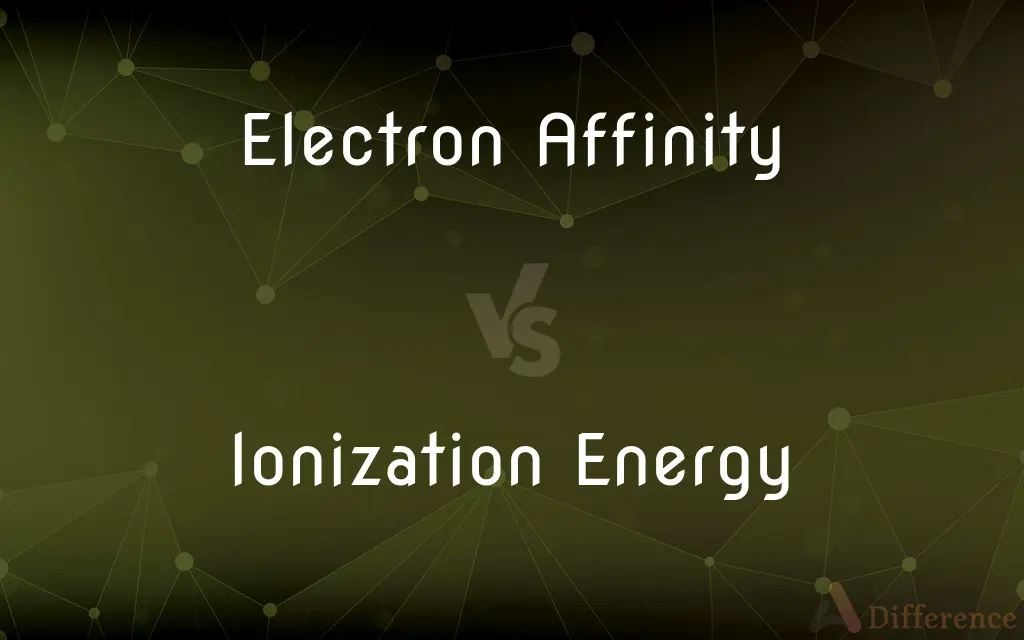Electron Affinity vs. Ionization Energy — What's the Difference?
By Tayyaba Rehman — Published on November 11, 2023
Electron affinity refers to the energy change when an electron is added to an atom, while ionization energy is the energy required to remove an electron from an atom.

Difference Between Electron Affinity and Ionization Energy
Table of Contents
ADVERTISEMENT
Key Differences
Electron Affinity and Ionization Energy are vital terms in the field of physical chemistry and atomic physics, primarily focusing on the behaviors of electrons within atoms. Electron Affinity relates to the energy change experienced by an atom when an electron is added to it, essentially measuring the atom’s likelihood to accept an additional electron. In comparison, Ionization Energy pertains to the amount of energy necessary to remove an electron from an atom, fundamentally expressing an atom’s reluctance to part with its electrons.
Electron Affinity can be perceived as an atom’s inherent electron “welcoming” nature, with some atoms, especially non-metals, generally possessing higher electron affinity because they are closer to achieving a stable electron configuration by gaining electrons. On the contrary, Ionization Energy presents an entirely divergent aspect, manifesting an atom’s “clinging” disposition toward its electrons, with higher values typically found among noble gases that naturally exhibit stable electronic configurations and hence, do not wish to lose electrons easily.
When diving into Electron Affinity, it is crucial to acknowledge that atoms with higher electron affinity are more prone to becoming negatively charged since they release energy upon gaining an electron. This released energy signifies a move toward a more stable state for the atom. In juxtaposition, Ionization Energy moves in an opposite theoretical direction, indicating that atoms with higher ionization energy, which resist electron removal, are more likely to maintain their neutral or positively charged state, avoiding the formation of cations only reluctantly.
While considering Electron Affinity, it’s essential to recognize that its values can be positive or negative, depending on whether energy is released or absorbed when an electron is added, impacting the atom’s proclivity to form anions. In parallel, Ionization Energy always demands energy input (endothermic process) to facilitate electron removal, hence its values are invariably positive, signifying the intrinsic stability of atoms and their general unwillingness to lose electrons without added energy.
In brief, Electron Affinity and Ionization Energy reflect the dual nature of atomic electron dynamics – with the former illuminating the energy landscape of electron acceptance and the latter elucidating the energetic cost of electron loss. Though disparate, both concepts critically scaffold our understanding of atomic stability, reactivity, and subsequent chemical behaviors, serving as foundational pillars in the architectural design of the periodic table and electronic theory in chemistry.
ADVERTISEMENT
Comparison Chart
Nature
Energy change upon adding an electron
Energy required to remove an electron
Typical Sign
Can be positive or negative
Always positive
Relation to Reactivity
Higher affinity may increase reactivity
Higher energy indicates low reactivity
Associated Charge
Can lead to an anionic state
Leads to a cationic state
Position in Periodic Table
Generally increases across a period
Generally increases across a period
Compare with Definitions
Electron Affinity
Periodic Table Trend
In the periodic table, Electron Affinity generally increases across a period.
Ionization Energy
Always Positive
Ionization Energy values are always positive as energy input is required.
Electron Affinity
Energy Change
Electron Affinity represents the energy change upon an electron's addition to an atom.
Ionization Energy
Periodic Table Trend
Ionization Energy typically increases as you move across a period in the periodic table.
Electron Affinity
Tendency Indicator
High Electron Affinity indicates a strong tendency to accept an electron.
Ionization Energy
Stability Indicator
Higher Ionization Energy indicates a stronger hold on its electrons.
Electron Affinity
Negative or Positive
Electron Affinity can possess either a positive or negative value.
Ionization Energy
Electron Removal
Ionization Energy quantifies the energy required to remove an electron from an atom.
Electron Affinity
Anion Formation
Atoms with higher Electron Affinity are more likely to form anions.
Ionization Energy
Cation Formation
An atom with high Ionization Energy is less likely to form cations.
Common Curiosities
Can Electron Affinity be negative?
Yes, Electron Affinity can be negative if energy is released upon gaining an electron.
What does Ionization Energy measure?
Ionization Energy measures the energy needed to remove an electron from an atom.
Is Ionization Energy always a positive value?
Yes, Ionization Energy is always positive since energy is required to remove an electron.
What is Electron Affinity?
Electron Affinity is the energy change experienced by an atom when an electron is added to it.
What unit is Ionization Energy measured in?
Ionization Energy is typically measured in electronvolts (eV) or kilojoules per mole (kJ/mol).
How is Electron Affinity related to atomic reactivity?
Higher Electron Affinity generally indicates an atom is more likely to accept electrons and thus may be more reactive.
Does higher Ionization Energy indicate low reactivity?
Yes, atoms with higher Ionization Energy are less likely to lose electrons and are generally less reactive.
Does Electron Affinity increase across the periodic table?
Generally, Electron Affinity increases across a period from left to right in the periodic table.
Why is Ionization Energy important?
Ionization Energy informs us about an atom's likelihood to form cations and its chemical reactivity.
Can Ionization Energy predict bond strength?
Yes, high Ionization Energy can suggest strong atomic bonding within a molecule.
Are Electron Affinity and Ionization Energy related to atomic size?
Yes, smaller atoms generally have higher Electron Affinity and Ionization Energy.
How does Electron Affinity affect molecular structure?
High Electron Affinity can influence an atom’s role in bonding and the structure of molecules.
What affects variation in Ionization Energy in the periodic table?
Electron configuration, shielding effect, and nuclear charge influence Ionization Energy variations.
Can atoms with high Electron Affinity form anions?
Yes, atoms with high Electron Affinity are more prone to form anions.
What factors influence Electron Affinity?
Electron configuration, atomic size, and element category can influence Electron Affinity.
Share Your Discovery

Previous Comparison
Database vs. Website
Next Comparison
Hazel Eyes vs. Brown EyesAuthor Spotlight
Written by
Tayyaba RehmanTayyaba Rehman is a distinguished writer, currently serving as a primary contributor to askdifference.com. As a researcher in semantics and etymology, Tayyaba's passion for the complexity of languages and their distinctions has found a perfect home on the platform. Tayyaba delves into the intricacies of language, distinguishing between commonly confused words and phrases, thereby providing clarity for readers worldwide.












































